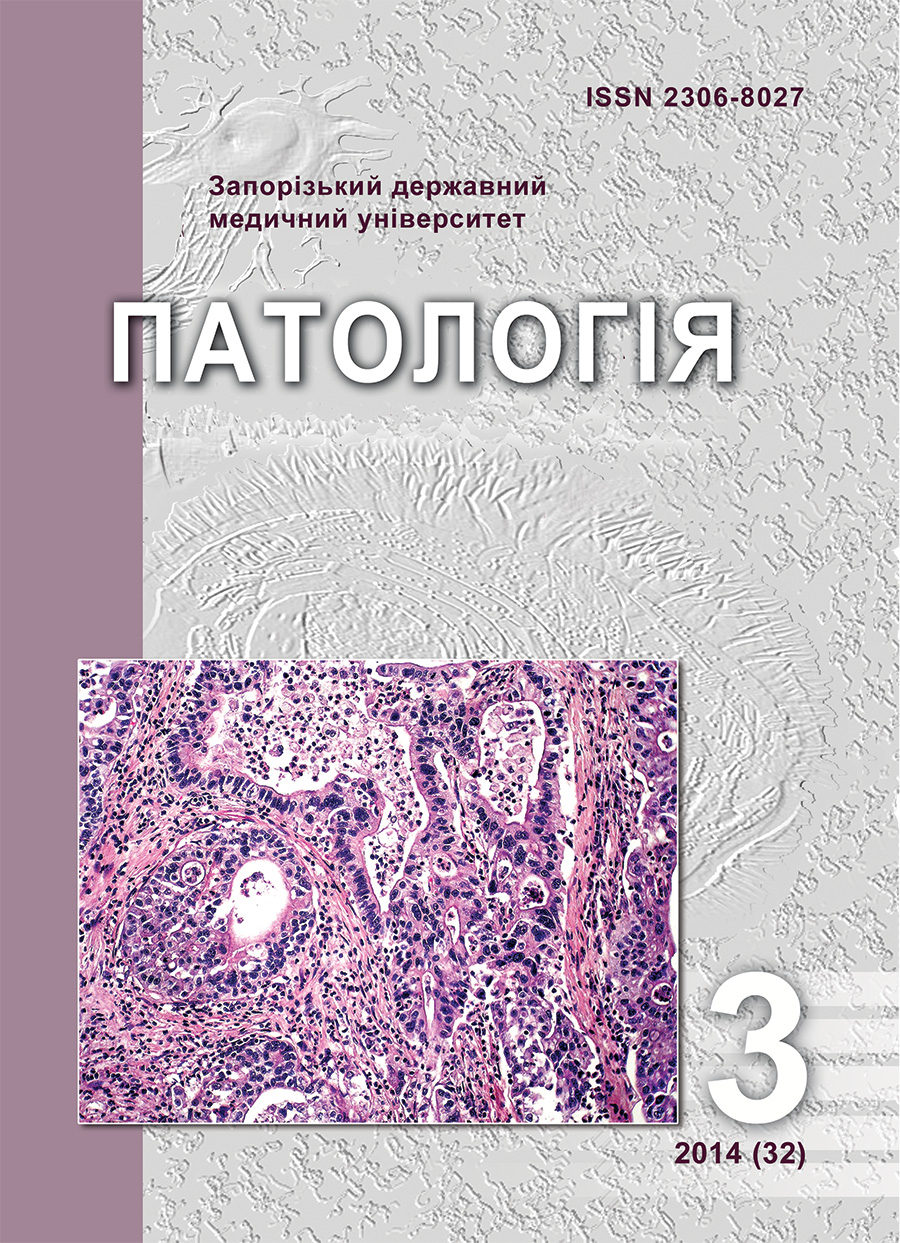Gastric hyperplastic polyps: immunohistochemical characteristic of proliferation and apoptosis
DOI:
https://doi.org/10.14739/2310-1237.2014.3.37045Keywords:
Stomach Diseases, Polyps, Cell Proliferation, ApoptosisAbstract
Aim. In order to research proliferation and apoptosis immunohistochemical study of expression of Ki-67 and Caspase-3 inbiopsies of 42 gastric hyperplastic polyps was conducted.
Methods and results. It was found that gastric hyperplastic polyps are characterized by middle expression level of Ki-67 (2,4±0,09 points) and extremely low expression level of Casp-3 (13,6±0,392 points) in surface foveolar cells, and also low expression level of Ki-67 (0,7±0,04 points) and middle expression level of Casp-3 (61,4±9,487 points) in cells of lamina propria. In hyperplastic polyps with middle and high epithelial dysplasia expression level of Ki-67 inepithelial cells and cells of lamina propria increases.
Conclusion. These results demonstrate the leading role of cell proliferation in progression of gastric hyperplastic polyps.
References
Barannikov, K. V., Shvydkyi, Ya. B., Tumak, I. M., & Lukavetskyi, N. O. (2013) Polipy shlunka: suchasna klasyfikatsiia, endoskopichna diahnostyka, vybir taktyky [Gastric polips: current classification, endoscopic diagnosis, choice of tactics]. Lvivskyi medychnyi chasopys, 19(4), 67–75. [in Ukrainian].
Pal`cev, M. A., & Anichkov, N. M. (2005) Atlas patologii opukholej cheloveka [Atlas of pathology of human tumors]. Moscow: Medicine. [in Russian].
Han, A. R., Sung, C. O., Kim, K. M., Park, C. K., Min, B. H., Lee, L. H., et al. (2009) The clinicopathological features of gastric hyperplastic polyps with neoplastic transformations: a suggestion of indication for endoscopic polypectomy. Gut and Liver, 3(4), 271–275. doi: 10.5009/gnl.2009.3.4.271.
Spaziani, E., Picchio, M., Filippo, A., Narilli, P., Pacini, L., Moretti, V., et al. (2012) Evaluation of the oncogenic risk of diffuse gastric polyposis. A case report. Revista Espanola de Enfermedades Digestivas, 104(9), 493–496.
Goddard, A. F., Badreldin, R., & Pritchard, D. M. (2010) The management of gastric polyps. Gut, 59, 1270–1276.
Ueyama, H., Matsumoto, K., Nagahara, A., Gushima, R., Hayashi, T., Yao, Y., & Watanabe, S. (2013) A white opaque substance-positive gastric hyperplastic polyp with dysplasia. World Journal of Gastroenterology, 19(26), 4262–4266. doi: 10.3748/wjg.v19.i26.4262.
Jung, J. T. (2013) Gastric Polyps and Protruding Type Gastric Cancer. Clinical Endoscopy, 46(3), 243–247. doi: 10.5946/ce.2013.46.3.243.
Vieth, M., & Stolte, M. (2006) Evaleted risk of gastric adenocarcinoma can be predicted from histomorphology. World Journal of Gastroenterology, 12(38), 6109–6114.
Jang, H. W., Jeong, H. Y., Kim, S. H., Kang, S. H., Seong, J. K., Song, K. S., & Moon, H. S. (2013) Adenocarcinoma occurring in a gastric hyperplastic polyp treated with endoscopic submucosal dissection. Journal of Gastric Cancer, 13(2), 117–120. doi: 10.5230/jgc.2013.13.2.117.
Petrov, S. V., & Rajkhlin, N. T. (2012) Rukovodstvo po immunogisokhimicheskoj diagnostike opukholej cheloveka [Guidance on immunohistochemical diagnosis of human tumors]. Kazan`: Title. [in Russian].
Downloads
How to Cite
Issue
Section
License
Authors who publish with this journal agree to the following terms:- Authors retain copyright and grant the journal right of first publication with the work simultaneously licensed under a Creative Commons Attribution License that allows others to share the work with an acknowledgement of the work's authorship and initial publication in this journal.

- Authors are able to enter into separate, additional contractual arrangements for the non-exclusive distribution of the journal's published version of the work (e.g., post it to an institutional repository or publish it in a book), with an acknowledgement of its initial publication in this journal.
- Authors are permitted and encouraged to post their work online (e.g., in institutional repositories or on their website) prior to and during the submission process, as it can lead to productive exchanges, as well as earlier and greater citation of published work (SeeThe Effect of Open Access).

